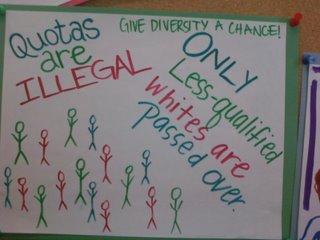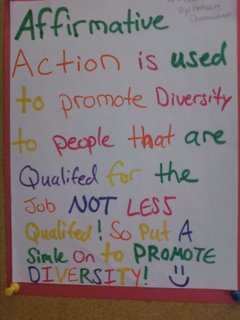Friday, October 10, 2008
Daily effects of indoctrination IV: Part 2
Yesterday's edition introduced us to the new board created by someone in the Community Studies department in the back stairwell of Stewart Hall here at SCSU. �I noted while walking around the building yesterday -- I work in a remote corner of the building, so I see lots of hallways and stairwells -- that that department has new bulletin boards up awaiting material. �As the song goes, I can't hardly wait.
The board in question provides responses to a counter-poster who had responded to a set of illustrations for an essay titled "Daily Effects of White Privilege." �It is written as "this is our response"; there are names on some of the responses that are also in the student directory, so I'm going to assume the students are a member of a class (perhaps a club instead, we should admit as a possibility.) �In either case a faculty member is with them as professor (or advisor.) �Let's look at a few more of these responses.
"simle" ... who has time for proofreading?Here's the point: I put a job description on a website for new PhDs to be new assistant professors on campus. I get a bunch of applications. The first cut of the pool is between those who are qualified for the job and those that are not. I can rank in some way, perhaps, those that are more qualified than others. But at the end of every job application process I have a tradeoff in front of me -- one candidate has a set of skills making her better in one area than the other, the other has a different skill set making him better in the other. How do I weight that? If some non-job characteristic like sex or race is counted as a criterion in the hiring process, then the process of trading off means that characteristic compensates for a lesser skill in something else. You can't say at the same time "we value diversity" and "there are no qualification differences between the diversity-preferred and diversity-unfavored candidates" because the latter means diversity had no value. A line has no width.

Again, the question -- in what way are they less qualified when we "give diversity a chance"? �Are they less qualified because they can't put a 'Y' or a '1' in the diversity box on the application screening form?� And notice the confusion here -- nothing that the counter-poster wrote said anything about quotas. �Is the professor or advisor doing any teaching here?
Now this one is very interesting. It suggests that the firm makes more profits by hiring on the basis of "goal-oriented affirmative action." (That term could mean numerous things, but in Minnesota it has a particular definition under state law.) If it really improves profits, why would a firm ever need a program? But this would allow for customer discrimination: If it improves my profits as a car dealer to have a male sales staff, I will prefer to hire only males. Now it might improve your profits because the State of Minnesota won't do business with a company of more than 40 employees on a contract over $100,000 unless you have one of thse goal-oriented affirmative action plans. But that's not the profit motive -- that's a use of the confiscatory power of the state to take tax dollars and use them to compel private firms to meet public goals.
More on Monday.
Labels: higher education, SCSU











